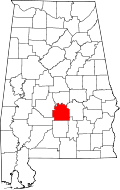2010 census
At the 2010 census there were 1,344 people, 512 households, and 348 families in the town. The population density was 240 inhabitants per square mile (93/km2). There were 592 housing units at an average density of 105.7 per square mile (40.8/km2). The racial makeup of the town was 75.5% Black or African American, 23.7% White and 0.6% from two or more races. 0.4% of the population were Hispanic or Latino of any race. [10] Of the 512 households 28.9% had children under the age of 18 living with them, 34.8% were married couples living together, 29.3% had a female householder with no husband present, and 32.0% were non-families. 28.9% of households were one person and 11.2% were one person aged 65 or older. The average household size was 2.63 and the average family size was 3.28.
The age distribution was 29.5% under the age of 18, 9.6% from 18 to 24, 22.1% from 25 to 44, 26.6% from 45 to 64, and 12.2% 65 or older. The median age was 34.3 years. For every 100 females, there were 86.9 males. For every 100 women age 18 and over, there were 76.7 men.
The median household income was $30,000 and the median family income was $31,591. Males had a median income of $41,579 versus $25,341 for females. The per capita income for the town was $14,411. About 19.4% of families and 22.2% of the population were below the poverty line, including 43.6% of those under age 18 and 25.4% of those age 65 or over.
2000 Census
At the 2000 census there were 1,270 people, 489 households, and 349 families in the town. The population density was 225.1 inhabitants per square mile (86.9/km2). There were 569 housing units at an average density of 100.9 per square mile (39.0/km2). The racial makeup of the town was 68.19% Black or African American, 31.50% White and 0.31% from two or more races. 0.47% of the population were Hispanic or Latino of any race. [11] Of the 489 households 35.0% had children under the age of 18 living with them, 39.3% were married couples living together, 27.4% had a female householder with no husband present, and 28.6% were non-families. 25.6% of households were one person and 9.6% were one person aged 65 or older. The average household size was 2.60 and the average family size was 3.12.
The age distribution was 29.8% under the age of 18, 8.6% from 18 to 24, 27.1% from 25 to 44, 21.7% from 45 to 64, and 12.8% 65 or older. The median age was 35 years. For every 100 females, there were 86.2 males. For every 100 women age 18 and over, there were 83.0 men.
The median household income was $20,433 and the median family income was $24,250. Males had a median income of $27,391 versus $20,882 for females. The per capita income for the town was $12,584. About 29.8% of families and 35.3% of the population were below the poverty line, including 42.8% of those under age 18 and 34.2% of those age 65 or over.








